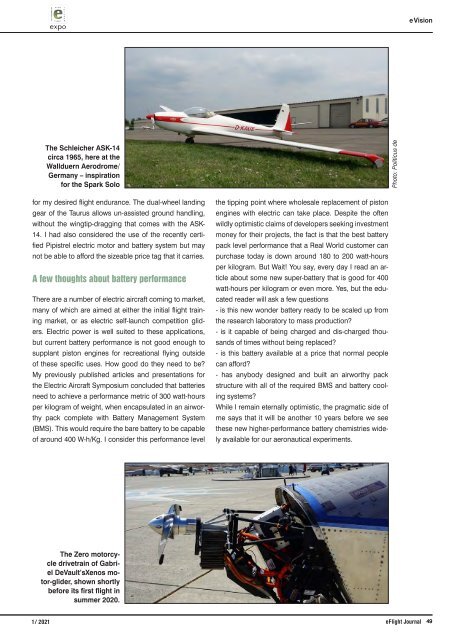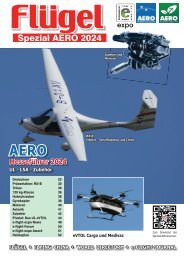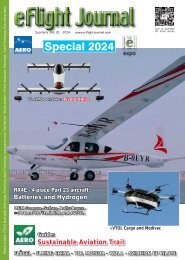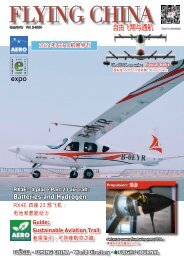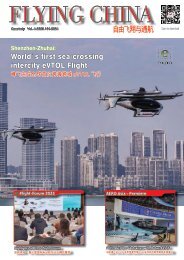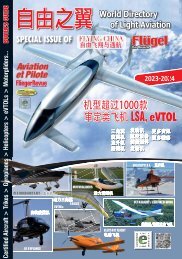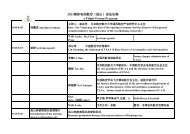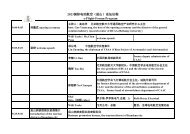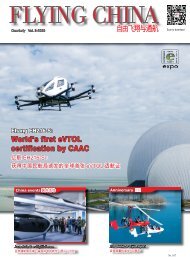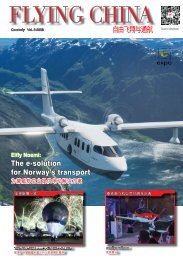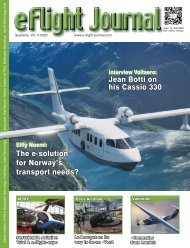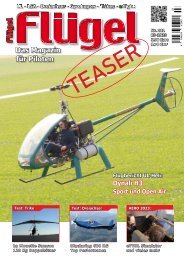eFlightJournal-04-2020+01-2021double issue
E-Flight Journal double issue The Journal for electric aviation, hybrid electrical Aircraft and Evtol from the Publisher Flying Pages
E-Flight Journal double issue
The Journal for electric aviation, hybrid electrical Aircraft and Evtol from the Publisher Flying Pages
You also want an ePaper? Increase the reach of your titles
YUMPU automatically turns print PDFs into web optimized ePapers that Google loves.
e Vision<br />
The Schleicher ASK-14<br />
circa 1965, here at the<br />
Wallduern Aerodrome/<br />
Germany – inspiration<br />
for the Spark Solo<br />
Photo: Politicus de<br />
for my desired flight endurance. The dual-wheel landing<br />
gear of the Taurus allows un-assisted ground handling,<br />
without the wingtip-dragging that comes with the ASK-<br />
14. I had also considered the use of the recently certified<br />
Pipistrel electric motor and battery system but may<br />
not be able to afford the sizeable price tag that it carries.<br />
A few thoughts about battery performance<br />
There are a number of electric aircraft coming to market,<br />
many of which are aimed at either the initial flight training<br />
market, or as electric self-launch competition gliders.<br />
Electric power is well suited to these applications,<br />
but current battery performance is not good enough to<br />
supplant piston engines for recreational flying outside<br />
of these specific uses. How good do they need to be?<br />
My previously published articles and presentations for<br />
the Electric Aircraft Symposium concluded that batteries<br />
need to achieve a performance metric of 300 watt-hours<br />
per kilogram of weight, when encapsulated in an airworthy<br />
pack complete with Battery Management System<br />
(BMS). This would require the bare battery to be capable<br />
of around 400 W-h/Kg. I consider this performance level<br />
the tipping point where wholesale replacement of piston<br />
engines with electric can take place. Despite the often<br />
wildly optimistic claims of developers seeking investment<br />
money for their projects, the fact is that the best battery<br />
pack level performance that a Real World customer can<br />
purchase today is down around 180 to 200 watt-hours<br />
per kilogram. But Wait! You say, every day I read an article<br />
about some new super-battery that is good for 400<br />
watt-hours per kilogram or even more. Yes, but the educated<br />
reader will ask a few questions<br />
- is this new wonder battery ready to be scaled up from<br />
the research laboratory to mass production?<br />
- is it capable of being charged and dis-charged thousands<br />
of times without being replaced?<br />
- is this battery available at a price that normal people<br />
can afford?<br />
- has anybody designed and built an airworthy pack<br />
structure with all of the required BMS and battery cooling<br />
systems?<br />
While I remain eternally optimistic, the pragmatic side of<br />
me says that it will be another 10 years before we see<br />
these new higher-performance battery chemistries widely<br />
available for our aeronautical experiments.<br />
The Zero motorcycle<br />
drivetrain of Gabriel<br />
DeVault’sXenos motor-glider,<br />
shown shortly<br />
before its first flight in<br />
summer 2020.<br />
1 / 2021<br />
e Flight Journal<br />
49


